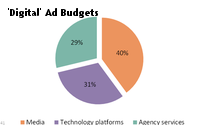 Despite current concerns
surrounding transparency issues such as fraud, non-human traffic and “viewability,” demand-side budgets for programmatic ad technology are expected to expand, according to an analysis
released late Thursday by Technology Business Research (TBR).
Despite current concerns
surrounding transparency issues such as fraud, non-human traffic and “viewability,” demand-side budgets for programmatic ad technology are expected to expand, according to an analysis
released late Thursday by Technology Business Research (TBR).
The analysis, which is based on a TBR survey of 240 ad technology users in North America and Western Europe, estimates
that only about 40% of digital advertising budgets are currently going toward “working media,” and that the second-biggest allocation -- 31% of budgets -- is going to pay for technology
used to process those media buys. Only 29% of the budgets are going to pay for agency services.
While the so-called digital ad “technology tax” isn’t surprising --
sources as varied as LUMA Partners’ Lumascapes analyses have estimated that only 40% of budgets go to working media, and others have claimed it is as low as 20% in some situations -- the TBR
analysis shows the proportion going to agencies services as well as technology.
TBR said 48% of ad technology users said they are allocating budgets to demand-side platforms, or
DSPs, for “direct-to-publisher” ad buys, but it did not provide an estimate for how much of it was being spent on secondary channels, such as advertising networks or audience
exchanges.
The conventional wisdom over the past several years is that big agencies, trading desks and big publishers have been gravitating toward so-called “private marketplaces”
in which they use programmatic technology to automate and facilitate media buys directly with publishers -- but various other sources, including Interpublic Mediabrands’ Magna Global, continue
to estimate a significant share of spending is being allocated to non-direct-to-publisher channels, such as open RTB.
Separately, TBR estimates that 45% of ad technology users
currently are spending budgets on “marketing attribution tools."
“Although the ad tech market is still nascent and fragmented, marketing cloud vendors, social media heavyweights and
enterprise pure plays are beginning to take dominant positions,” the TBR analysis notes, adding: “As digital advertising formats capture an increasingly larger proportion of global ad
spend, the infrastructure, intelligence and ROI ad tech platforms deliver become strategic pillars for brands.”
For some perspective, TBR Senior Analyst Seth Ulinski noted that the
study is based on estimated ad budgets for 2016 and covers companies sized from 500 to 1,000 employees, 1,000 to 5,000 employees and 5,000-plus employees.